HUMAN RESOURCE MANGEMENT






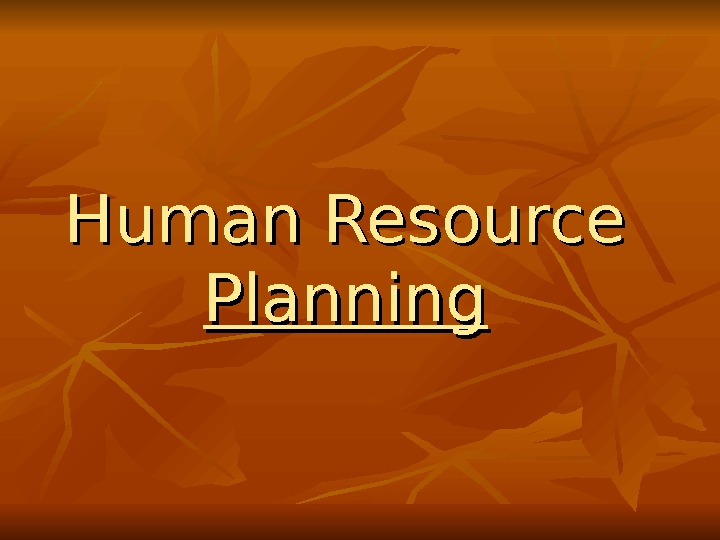

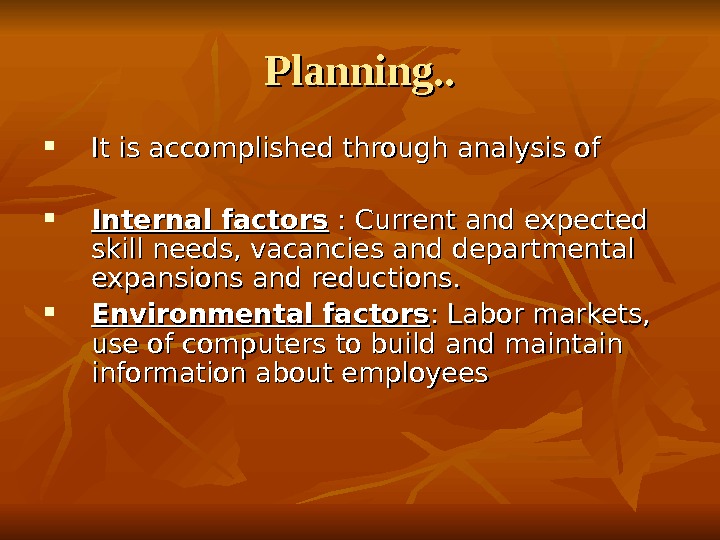

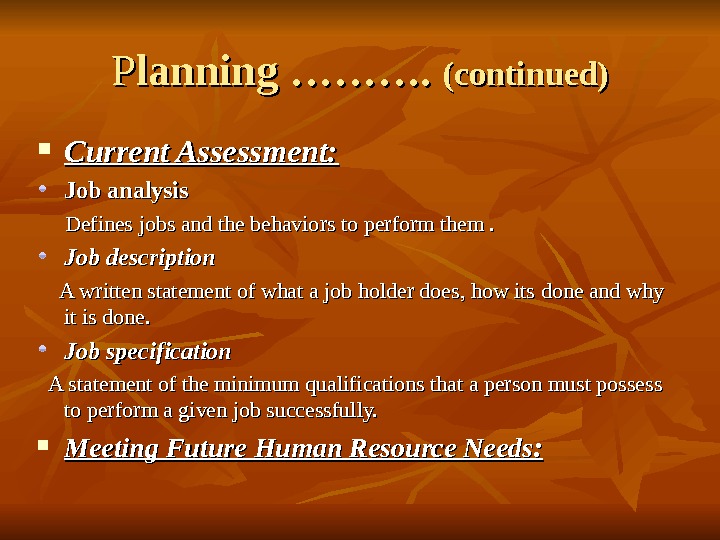

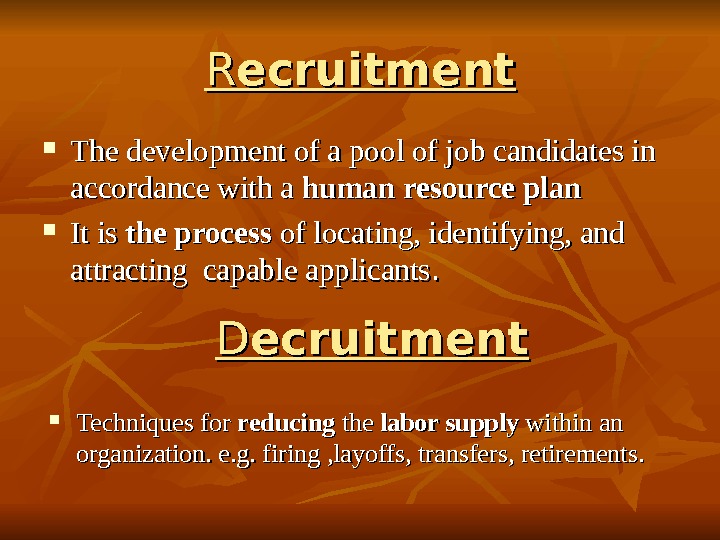




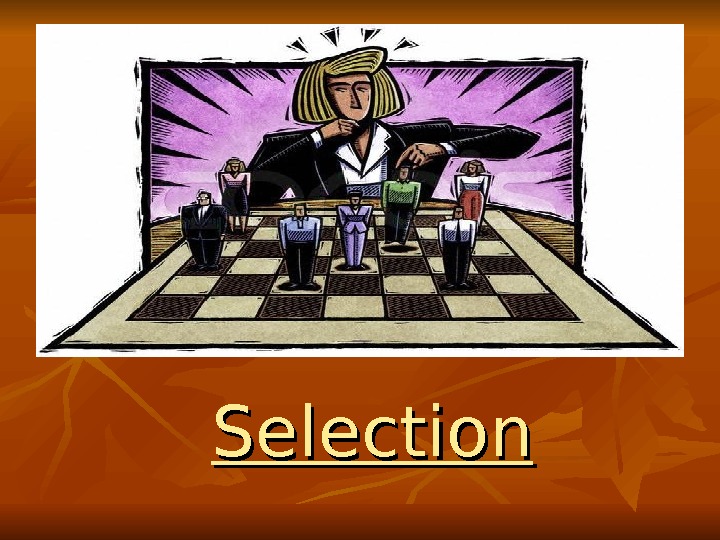


























- Размер: 1.5 Mегабайта
- Количество слайдов: 43
Описание презентации HUMAN RESOURCE MANGEMENT по слайдам
 HUMAN RESOURCE MANGEMENT PROCESS
HUMAN RESOURCE MANGEMENT PROCESS
 MM embers PP resenting:
MM embers PP resenting:
 What is HUMAN RESOURCE MANAGEMENT The management function that deals with recruitment, placement, training, development of organization members. HRMHRM is a process for staffing the organization and sustaining high employee performance. HRMHRM can be defined as all the practices , , systems and procedures implemented to attract, acquire, develop and manage human resources to achieve the goals of an organization. Simply it is managing the employment relationship
What is HUMAN RESOURCE MANAGEMENT The management function that deals with recruitment, placement, training, development of organization members. HRMHRM is a process for staffing the organization and sustaining high employee performance. HRMHRM can be defined as all the practices , , systems and procedures implemented to attract, acquire, develop and manage human resources to achieve the goals of an organization. Simply it is managing the employment relationship
 Importance of “Human Resource Management” Staff is the most important resource of an organization. Human resource is the key ingredient to success. ““ Human resource” creates organizational accomplishments and innovations.
Importance of “Human Resource Management” Staff is the most important resource of an organization. Human resource is the key ingredient to success. ““ Human resource” creates organizational accomplishments and innovations.
 Components of a HRM System Recruitment/ Decruitment Training/Training/ Development. Compensation &Compensation & Benefits Performance Management Human Resource Planning Orientation Selection Career Development HRMHRM
Components of a HRM System Recruitment/ Decruitment Training/Training/ Development. Compensation &Compensation & Benefits Performance Management Human Resource Planning Orientation Selection Career Development HRMHRM
 Human Resource Planning
Human Resource Planning
 HRM “ “ Planning” Human resource planning is designed to ensure the future personnel needs will be constantly and appropriately met. The process by which managers ensure that they have the right number and kinds of people in the right places, and at the right times, who are capable of effectively and efficiently performing assigned tasks.
HRM “ “ Planning” Human resource planning is designed to ensure the future personnel needs will be constantly and appropriately met. The process by which managers ensure that they have the right number and kinds of people in the right places, and at the right times, who are capable of effectively and efficiently performing assigned tasks.
 Planning. . It is accomplished through analysis of Internal factors : Current and expected skill needs, vacancies and departmental expansions and reductions. Environmental factors : Labor markets, use of computers to build and maintain information about employees
Planning. . It is accomplished through analysis of Internal factors : Current and expected skill needs, vacancies and departmental expansions and reductions. Environmental factors : Labor markets, use of computers to build and maintain information about employees
 HH uman RR esource PP lanning (continued) Human resource planning must be integrated within the organizations strategic plans Senior management must emphasize the importance of human resource planning Human resource planning must be based on the most accurate information available. A clear plan must be developed with associated time-spans and scope of activity.
HH uman RR esource PP lanning (continued) Human resource planning must be integrated within the organizations strategic plans Senior management must emphasize the importance of human resource planning Human resource planning must be based on the most accurate information available. A clear plan must be developed with associated time-spans and scope of activity.
 PP lanning ………. (continued) Current Assessment: Job analysis Defines jobs and the behaviors to perform them. Job description A written statement of what a job holder does, how its done and why it is done. Job specification A statement of the minimum qualifications that a person must possess to perform a given job successfully. Meeting Future Human Resource Needs:
PP lanning ………. (continued) Current Assessment: Job analysis Defines jobs and the behaviors to perform them. Job description A written statement of what a job holder does, how its done and why it is done. Job specification A statement of the minimum qualifications that a person must possess to perform a given job successfully. Meeting Future Human Resource Needs:
 Recruitment & Decruitment
Recruitment & Decruitment
 RR ecruitment The development of a pool of job candidates in accordance with a human resource plan It is the process of locating, identifying, and attracting capable applicants. . DD ecruitment Techniques for reducing the labor supply within an organization. e. g. firing , layoffs, transfers, retirements.
RR ecruitment The development of a pool of job candidates in accordance with a human resource plan It is the process of locating, identifying, and attracting capable applicants. . DD ecruitment Techniques for reducing the labor supply within an organization. e. g. firing , layoffs, transfers, retirements.
 Recruitment…. (continued) Job description : : A written description of a non-management job, covering title, duties and responsibilities and including its location on the organization chart. Position description: A written description of a management position. Hiring specification: It defines the education, experience and skills an individual must have in order to perform effectively in the position he/she is applying
Recruitment…. (continued) Job description : : A written description of a non-management job, covering title, duties and responsibilities and including its location on the organization chart. Position description: A written description of a management position. Hiring specification: It defines the education, experience and skills an individual must have in order to perform effectively in the position he/she is applying
 Sources Of recruiting Potential Job Candidates Labor market: Easy to recruit in large labor markets. . The type or level of the position: The more specialized the position the more recruitment efforts. The size of the organization: The larger the organization the easier it is to recruit.
Sources Of recruiting Potential Job Candidates Labor market: Easy to recruit in large labor markets. . The type or level of the position: The more specialized the position the more recruitment efforts. The size of the organization: The larger the organization the easier it is to recruit.
 Process of Recruitment Steps in the Recruitment process: Internal Search Advertisement of a job vacancy. Web based advertising. Preliminary contact with potential job candidates. Initial screening to create a pool of qualified applicants. Methods of Recruitment process: External Recruitment Internal Recruitment
Process of Recruitment Steps in the Recruitment process: Internal Search Advertisement of a job vacancy. Web based advertising. Preliminary contact with potential job candidates. Initial screening to create a pool of qualified applicants. Methods of Recruitment process: External Recruitment Internal Recruitment
 RR ecruitment PP olicies Source : Current ABC c Employees Internal and external Advertisements Data Bank Employment Agencies and consultants
RR ecruitment PP olicies Source : Current ABC c Employees Internal and external Advertisements Data Bank Employment Agencies and consultants
 Selection
Selection
 Selection The process of assessing candidates and appointing a post holder to ensure that the most appropriate candidates are hired. The scheme used for optimally staffing the organization
Selection The process of assessing candidates and appointing a post holder to ensure that the most appropriate candidates are hired. The scheme used for optimally staffing the organization
 Selection Validity and Reliability Validity Reliability The proven relationship that exists between a selection device and some relevant job criterion The ability of a selection device to measure the same thing consistently
Selection Validity and Reliability Validity Reliability The proven relationship that exists between a selection device and some relevant job criterion The ability of a selection device to measure the same thing consistently
 Selection Criteria 1. 1. Completed Job Applications: This step indicates the employee desire position and this application provides information useful for interviews. 2. 2. Interviews: It is most common method in which selection committee evaluates a candidate’s abilities by following methods:
Selection Criteria 1. 1. Completed Job Applications: This step indicates the employee desire position and this application provides information useful for interviews. 2. 2. Interviews: It is most common method in which selection committee evaluates a candidate’s abilities by following methods:
 Selection Criteria (continued) Types Of Interviews: Testing: To measure the job and learning skills of the candidate. Initial Screening: A type of interview in which questions are asked about experience of the candidate and his salary expectations PP anel and SS erial interviews. To evaluate a candidate for the job.
Selection Criteria (continued) Types Of Interviews: Testing: To measure the job and learning skills of the candidate. Initial Screening: A type of interview in which questions are asked about experience of the candidate and his salary expectations PP anel and SS erial interviews. To evaluate a candidate for the job.
 Steps In Selection (continued) • In Depth Selection Interviews: These interviews are conducted by the manager to whom the applicant will report. The objective of this step is to find out more about applicant as an individual. . 3. 3. Background Checks: Selection committee confirm the truthfulness of application Résumé or of the application form. The previous supervisor of the applicant is called to confirm this information and to get his career highlights.
Steps In Selection (continued) • In Depth Selection Interviews: These interviews are conducted by the manager to whom the applicant will report. The objective of this step is to find out more about applicant as an individual. . 3. 3. Background Checks: Selection committee confirm the truthfulness of application Résumé or of the application form. The previous supervisor of the applicant is called to confirm this information and to get his career highlights.
 Steps In Selection (continued) 4. Physical Examination: It is conducted to ensure the physical fitness of applicant. REALISTIC JOB PREVIEW: A preview of the job that provides both positive and negative information about the job and the company.
Steps In Selection (continued) 4. Physical Examination: It is conducted to ensure the physical fitness of applicant. REALISTIC JOB PREVIEW: A preview of the job that provides both positive and negative information about the job and the company.
 Steps In Selection (continued) Welcome Position / title Authority, duties and responsibilities Starting date, normal work hours Starting salary Benefit package Other — probationary period, travel, etc. 5. Job Offer:
Steps In Selection (continued) Welcome Position / title Authority, duties and responsibilities Starting date, normal work hours Starting salary Benefit package Other — probationary period, travel, etc. 5. Job Offer:
 OO rientation
OO rientation
 OO rientation Introduction of a new employee to his/her job and the organization. A program designed to help employees fit smoothly into an organization; also called socialization. Orientation or socialization is designed to provide new employees with the information needed to function comfortably and effectively in the organization.
OO rientation Introduction of a new employee to his/her job and the organization. A program designed to help employees fit smoothly into an organization; also called socialization. Orientation or socialization is designed to provide new employees with the information needed to function comfortably and effectively in the organization.
 OO rientation (continued) It conveys three types of information: 1. 1. General information about daily work routine. 2. 2. Review of organization’s history , purpose operations, and products or services and contribution of employee’s job to the organization’s needs. 3. 3. Presentation of organization’s policies, work rules and employee benefit.
OO rientation (continued) It conveys three types of information: 1. 1. General information about daily work routine. 2. 2. Review of organization’s history , purpose operations, and products or services and contribution of employee’s job to the organization’s needs. 3. 3. Presentation of organization’s policies, work rules and employee benefit.
 Types of of OO rientation Two types of orientation: 1. 1. Work unit orientation: Familiarizes employee with goals of work unit, contribution to the unit’s goals, introduction to co-workers. 2. 2. Organization orientation: Informs employee about the organization’s objectives, history , philosophy procedures and rules, human resource policies and benefits. Tour of organization’s work facilities.
Types of of OO rientation Two types of orientation: 1. 1. Work unit orientation: Familiarizes employee with goals of work unit, contribution to the unit’s goals, introduction to co-workers. 2. 2. Organization orientation: Informs employee about the organization’s objectives, history , philosophy procedures and rules, human resource policies and benefits. Tour of organization’s work facilities.
 Training
Training
 Training Programs A A process designed to maintain or or improve current job performance. Most training is directed at upgrading and improving an an employee’s abilities or skills.
Training Programs A A process designed to maintain or or improve current job performance. Most training is directed at upgrading and improving an an employee’s abilities or skills.
 Developmental Programs A A process designed to develop skills necessary for future work activities.
Developmental Programs A A process designed to develop skills necessary for future work activities.
 Difference between Training and Developmental Programs Training is for the current improvement in the job while developmental program is for improving the skill which will be used in the future. . Both managers and non-managers receive help from training and developmental program but mostly non-managers are concerned with training while the managers are concerned with developmental programs.
Difference between Training and Developmental Programs Training is for the current improvement in the job while developmental program is for improving the skill which will be used in the future. . Both managers and non-managers receive help from training and developmental program but mostly non-managers are concerned with training while the managers are concerned with developmental programs.
 Why. Why Training and Developmental Program? To improve three types of skills 1)1) Technical skills 2)2) Interpersonal skills 3)3) Problem solving skills
Why. Why Training and Developmental Program? To improve three types of skills 1)1) Technical skills 2)2) Interpersonal skills 3)3) Problem solving skills
 Training Methods 1)1) Most training takes place on the job because this approach is simple and inexpensive. 2)2) Some skill training is too complex to learn on the job. in such cases it should take place outside the work setting.
Training Methods 1)1) Most training takes place on the job because this approach is simple and inexpensive. 2)2) Some skill training is too complex to learn on the job. in such cases it should take place outside the work setting.
 Employees Performance Management
Employees Performance Management
 Employee Performance Management Performance management is a process used within organization to establish and evaluate an individual’s job performance to achieve goals and objectives. .
Employee Performance Management Performance management is a process used within organization to establish and evaluate an individual’s job performance to achieve goals and objectives. .
 Performance Management Performance Appraisal A process of systematically evaluating performance and providing feedback upon which performance adjustments can be made. Performance appraisal should be based on job analysis, job description, and job specifications.
Performance Management Performance Appraisal A process of systematically evaluating performance and providing feedback upon which performance adjustments can be made. Performance appraisal should be based on job analysis, job description, and job specifications.
 Types of of PP erformance AA ppraisal Informal Performance Appraisal: “ “ The process of continually feeding back to subordinates information regarding their work performance” Formal Performance Appraisal: “ “ A formalized appraisal process for rating work performance, identifying deserving raises or promotions, and identifying those in need of further training”.
Types of of PP erformance AA ppraisal Informal Performance Appraisal: “ “ The process of continually feeding back to subordinates information regarding their work performance” Formal Performance Appraisal: “ “ A formalized appraisal process for rating work performance, identifying deserving raises or promotions, and identifying those in need of further training”.
 Graphic Rating Scale. Written Essays Critical Incidents 360 Degree Feedback Multiperson Comparisons BARS Behavioral Anchored Rating Scales Performance Appraisal Methods
Graphic Rating Scale. Written Essays Critical Incidents 360 Degree Feedback Multiperson Comparisons BARS Behavioral Anchored Rating Scales Performance Appraisal Methods
 Compensation And Benefits
Compensation And Benefits
 Compensation and benefits Benefits of a Fair, Effective, and Appropriate Compensation System Helps attract and retain high-performance employees Impacts on the strategic performance of the firm Types of Compensation Base wage or salary Wage and salary add-ons Incentive payments Skill-based pay
Compensation and benefits Benefits of a Fair, Effective, and Appropriate Compensation System Helps attract and retain high-performance employees Impacts on the strategic performance of the firm Types of Compensation Base wage or salary Wage and salary add-ons Incentive payments Skill-based pay
 Factors That Influence Compensation and Benefits Level of Compensation and Benefits. Employee’s Tenure and Performance Size of Company Kind of Job Performed Company Profitability Kind of Business Geographical Location Unionization Management Philosophy Labour- or Capital-Intensive. How long has employee been with company and how has he or she performed? Does job require high levels of skills? What industry is job in? Is business unionized? Is business labour- or capital-intensive? How large is the company? How profitable is the company? Where is organization located? What is management’s philosophy toward pay?
Factors That Influence Compensation and Benefits Level of Compensation and Benefits. Employee’s Tenure and Performance Size of Company Kind of Job Performed Company Profitability Kind of Business Geographical Location Unionization Management Philosophy Labour- or Capital-Intensive. How long has employee been with company and how has he or she performed? Does job require high levels of skills? What industry is job in? Is business unionized? Is business labour- or capital-intensive? How large is the company? How profitable is the company? Where is organization located? What is management’s philosophy toward pay?


